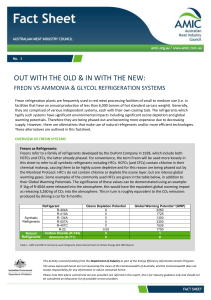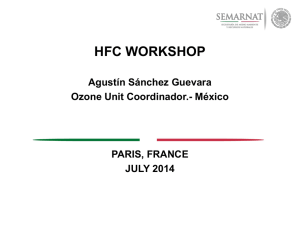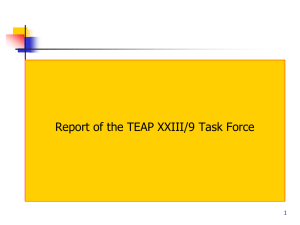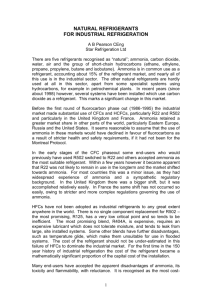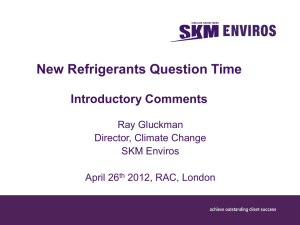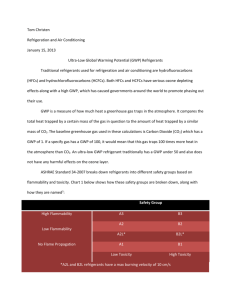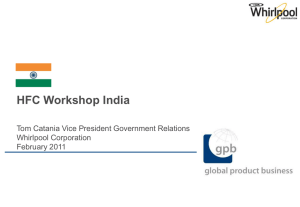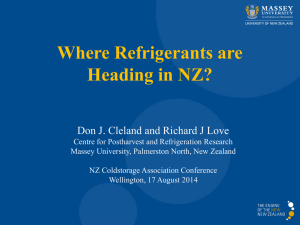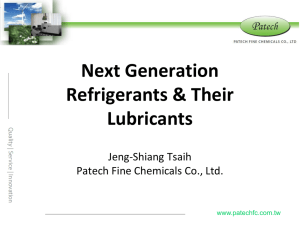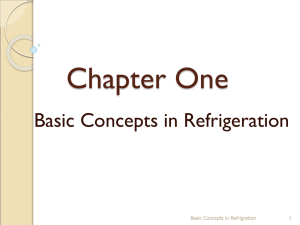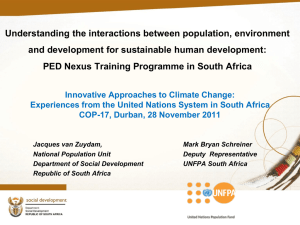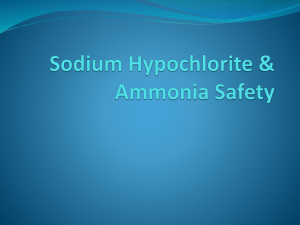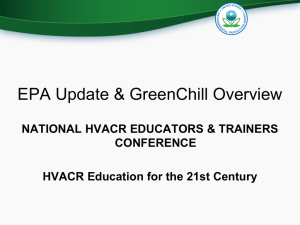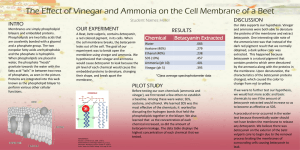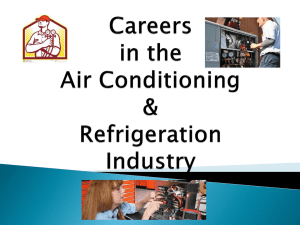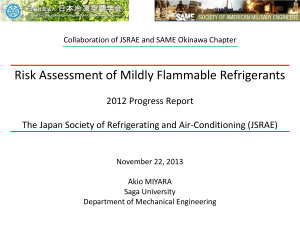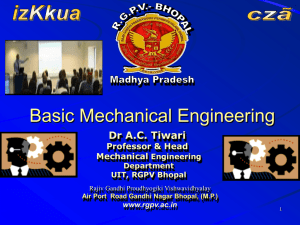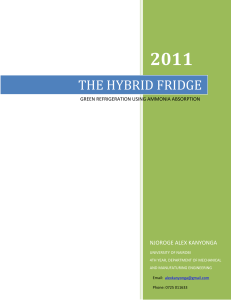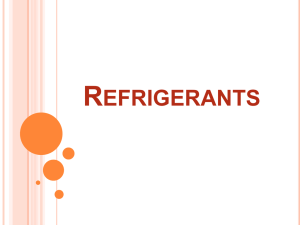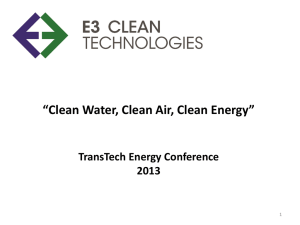European regulations PED 97/23 EC, EN 378
advertisement
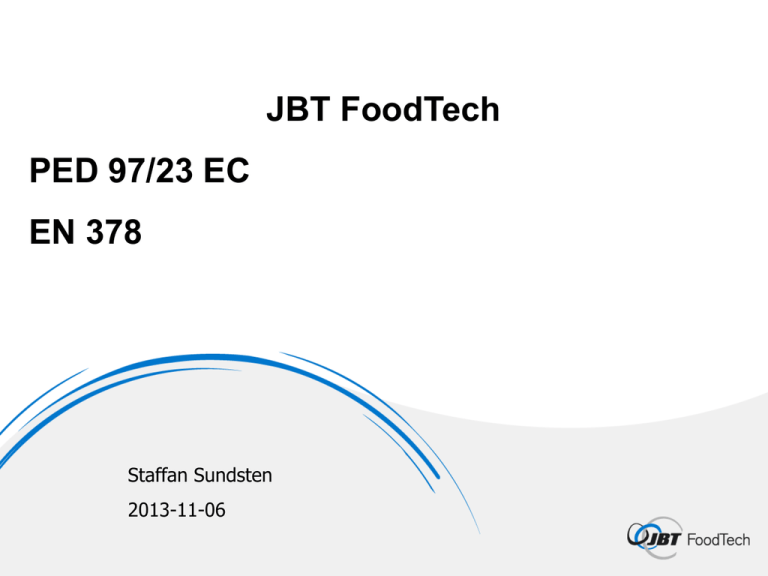
JBT FoodTech PED 97/23 EC EN 378 Staffan Sundsten 2013-11-06 CE-marking…why? Before all countries had there local regulations… Easier product trade in europe and worldwide Safer products both for environmental and humans CE-mark secures manufactor taking full responsibility regarding european directives CE = “Conformité Européenne” wich means fulfills CE-directives CE-directives = European Law 2 Refrigeration directives… Pressure Equipment Directive - 97/23 EC (PED) Machine directive - 2006/42 EC (MD) Low Voltage directive - 2006/95/EC (LVD) Electromagnetical directive - 2004/108/EG EN 378-2 = C-standard Design according to this standard means 3 Directives Fulfilled! Pressure Equipment Directive (PED 97/23 EC) The pressure equipment is classified according to 4 categories (I-IV) The categories are determined by: – Pressure (max pressure the equipment is made for) – Volume (for pipes: diameter) – Content (medium) The category is set with the help of nine (9) different diagrams Diagram 1- Pressure vessels, Ps= Max allowed pressure in bar that the supplier state that the pressure vessel are designed after. Diagram 7. Pipes, DN = The nominal size of the pipe. Pressure Equipment Directive (PED 97/23 EC) The category give a so called Module according to the table below. The Module gives the extent of the control required. Category I Category II Category III Category IV Module A Module A1 Module D1 Module E1 Module B1 + D Module B1 + F Module B+ E Module B + C1 Module H Module B + D Module B + F Module G Module H1 Pressure Equipment Directive (PED 97/23 EC) technical file… Module G: General description assembly (system overview) Flowchart List of used standards Design calculation Declarations of conformity Risk assessment PED/MD Technical file installation (WPQ,PQR, NDT….) Design standard refrigeration systems world wide European refrigeration standard: EN 378 American refrigeration standard: ISO/CD 5149 Australian refrigeration standard: AS/NZS 1677 9 To fulfill directives there are harmonized standards… EN 378:2008 Refrigeration systems and heat pumps… EN 378-1 Safety and environmental requirements. EN 378-2 Design, construction, testing, marking and documentation. EN 378-3 Installation site and personal protection. EN 378-4 Operation, maintenance, repair and 10 recovery. Other important standards related to EN 378-2… EN 13136 Refrigeration system (design capacity safety relief valves/lines) EN14276 (general requirements of pressure vessels/pipes refrigeration) EN 13480 (industrial piping…welding and materials) EN 13445 (design pressure vessels) EN 10216 (Approved Low temperature 11 materials)… What do we sell? Modules/units JBT delivers units and separate declaration of conformities Plant JBT delivers a complete unit but the customer is responsible for integration and an accredited notified body approves installation. CE certificates on sub units. Assembly JBT delivers a complete assembly– JBT is integrator and supplies CE certificate on system Who is the integrator and responsible for the approval? There are three different players in the project that can take on the roll as an integrator: Refrigeration contractor - The company installing piping and the other equipment. JBT – In this case JBT delivers a complete refrigeration system with subunits from several different suppliers, including piping. The customer – In this case the customer is building the system himself with internal resources. 13 Important to buy components as part assemblies and decide who is integrator! Pipes Vessels Condensor Compressor Pack LVS 14 Approval process with notified body… Design & documentation communicated - Design -Declaration of conformity - Calculations safety relief line&pipes - Risk analysis etc Pressure test & 1st inspection Approval installation refrigeration system -operators manual - Manufactor plate - Technical file installation company Approval technical file to EN 378-2 Design and documentation according Final approval - JBT declaration of conformity - Certificate from notified body 15 Declaration of Conformity according to 97/23 EC… should contain: Name and address manufacture Description of pressure equipment/Assembly Module and Category Harmonized standards used References of other applied directives Name and address of notified body Sign from authorized represented manufacture Certificate examination 16 See example of JBT-declaration… See example of JBT-declaration… Word document 17 Learnings approval process Declaration of conformity according to PED 97/23 Safety relief valves (calculations, pressure protocol, design etc) To check that over flow valves are safety valve approved Minimum Pipe thickness to be calculated all projects Risk assessment according to MD 2006/42 and PED 97/23 all projects where JBT Foodtech is integrator. To assure that installation company have welders certificate that covers pipe sizes 18 Some remarks from inspections with notified body… Remark: Overflow valve not approved as safety valve! Remark: Safety valve flanges not approved! Action: Change flanges Action: Change valve and repipe. 19 Second hand Pressure equipment PED 97/23 EC The application of and compliance with the Directive is mandatory from 29 May 2002. Equipment manufactured before : Fulfill directive 89/655 EC (minimum directive for working equipment ) or to fulfill local rules Need to check with local notified body the demand of: - Documentation - Risk assessment 20 SOME REFRIGERANTS AND ITS IMPACT ON ENVIRONMENT AND HUMAN SAFETY 21 NATURAL REFRIGERANTS Natural refrigerants are the answer for high capacity and high efficiency operation. • • • • • Air - R 729 Water - R 718 Ammonia - R 717 Carbon dioxide - R 744 Hydrocarbons, such as propane - R 290 and isobutane - R 600a 22 NH3 – Ammonia - Because of the characteristic smell, ammonia it is the only refrigerant in the world that warns long before it is dangerous and gives persons chance to move away. - Ammonia is toxic when inhaling, corrosive to the eyes, respiratory, skin and flammable at certain conditions. - Therefor it has to be treated with care and all ammonia systems must be designed with safety in mind. - At the same time, unlike most refrigerants, Ammonia has a characteristic smell that can be detected by humans at very low concentrations which give a warning signal if having leakage. - Already at around 20-25 ppm you will feel very uncomfortable. 23 Energy efficiency Ammonia is one of the most energy-efficient applications, the application range from high to low temperature. Normally flowing ammonia system is 15-20% more energy efficient than a DX R404A counterpart. Environment Ammonia is the most environmentally friendly refrigerant. It belongs to the group of so-called "natural" refrigerants, and it has both GWP (Global Warming Potential) and ODP (ozone depletion potential) of zero Smaller pipe sizes Both vapour and liquid ammonia requires smaller diameter than most chemical refrigerants. 24 Better heat transfer Ammonia has better heat transfer properties than the majority of chemical refrigerants and therefore allows devices with a smaller heat transfer area used. These properties also favours the thermodynamic efficiency of the system and reduces the operational costs of the system. Refrigerant cost In many countries, the cost of ammonia (per kg) significantly lower than the cost of HFC Safety As described earlier, Ammonia is toxic when inhaling, corrosive to the eyes, respiratory, skin and flammable at certain conditions. That is why it must be handled carefully, and all the ammonia systems must be designed with safety in mind. 25 In Sweden: NGV (24 h): 20 ppm TGV (15 min): 50 ppm Alarm levels: C: Leakage, non acute: 50 - 300ppm B: Acute: 500 - 1000ppm A. High level , plant is stopped = Protection of people > 3000ppm 26 SYNTHETIC REFRIGERANTS 1. CFC (Clorofluorcarbon - a member of the FC family containing only chlorine, fluorine and carbon.) The Montreal Protocol of 1987 has phased out the production of CFC refrigerants. CFC is not to be used at all since January 1, 2000. The actual CFC refrigerants are: R 12, and azeotropic blend R 502. 27 2. HCFC (Hydrofluorocarbon - a member of FC family containing hydrogen, chlorine, fluorine and carbon.) HCFC has limited future for new design. HCFC are not allowed to be used in new installations or to re fill. A total stop is expected from Jan 1, 2015. The main HCFC refrigerant is: R 22 and blends with R 22. 28 3. HFC (Fluorohydrocarbons - a family of chemicals containing fluorine hydrogen and carbon.) HFC refrigerants are the answer to many refrigeration applications. Pure HFC or blends should be avoided for large size food freezing and food preservation. Below some HFC as alternatives to R 22 29 R134a can be an option upon conversion in cases where a power loss can be accepted or if the compressor displacement can be increased enough without other factors adversely affected. Suitable mainly for chilling applications. Oil change required R404a (R507) is usually the best option in the refrigerator and freezer facilities but an increase in power output and higher condensing pressure must be considered. In air conditioning the energy efficiency is reduced and electrical output will increase significantly. Oil change required. 30 R407C is a proven alternative in facilities with appropriate heat exchangers but requires that the oil is changed to ester oil except in rotary compressors which typically special low viscosity alkyl benzene oils are recommended. R417A (Isceon 59) is poorly documented but is interesting when the cost of oil change is considered too high while capacity reduction and some uncertainty is acceptable, for example, if the unit is to be replaced relatively soon. R410A is not an option for conversion of existing R22 systems 31 For small refrigeration plants (~30-50 kW), HFC is attractive since the investment is much less than if installing an ammonia plant. Freon's are not normally considered as dangerous for people, but it is well known that Freon's has a very big impact on the environment. 32 GWP Global warming potential, compared to the GWP of CO2. All GWP figures here are based on the 100 year time horizon. ODP Ozone Depletion Potential - compared to ODP of R 11 which is defined as 1. Refrigerant R 22 HCFC R 134a HFC pure refrigerant R 404A HFC zeotropic blend R 407C HFC zeotropic blend R 410A HFC zeotropic blend R 507 HFC azeotropic blend R 290 propane R 600a isobutane R 717 ammonia 33 R 744 carbon dioxide ODP 0.055 0 0 0 0 0 0 0 0 0 GWP 1700 1300 3800 1600 1900 3800 3 3 0 1 34

